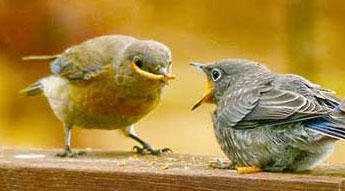
Mealworms Are for the Birds
Many birds eat insects when they are out foraging, so feeding mealworms to birds is a natural thing to do. Plus, you’ll enjoy watching birds such as chickadees, bluebirds, wrens, towhees, woodpeckers, robins, nuthatches and others devour these mouth-watering morsels! A Red-breasted Nuthatch was seen taking mealworms from a feeder and caching them at a rate of three per minute.
Mealworms are the larvae of the beetle Tenebrio molitor. The larvae stage of the beetle typically lasts for 10 weeks. To maintain the larvae in a state of dormancy, they must be refrigerated at 40 to 50 degrees Fahrenheit (lower temperatures can kill the larvae). You can keep mealworms for several weeks and they will maintain their dormant state.
Birds typically look for food around the same time each day, so you can place worms in a slippery-sided feeder or tray at the same time the birds regularly visit. Make sure the birds can access the feeder but that the worms can’t crawl out! Some Wild Birds Unlimited feeders to consider are the Dinner Bell™ feeders. Mealworms are a great way to attract birds that don’t ordinarily come to seed feeders.
Lots of our customers buy our fresh mealworms to feed to birds from chickadees to bluebirds, like those shown here, but some wonderful folks also get them for other pets they care for, like reptiles and marsupials, like Sugar Gliders...
Photo by Stephanie Hazen, mother Western Bluebird feeding a mealworm to her youngster

